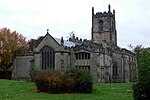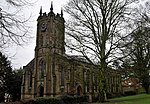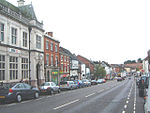Packington
Civil parishes in LeicestershireNorth West Leicestershire DistrictUse British English from July 2015Villages in Leicestershire

Packington is a village and civil parish in the district of North West Leicestershire. It is situated close to the A42 road and the towns of Ashby de la Zouch and Measham. The population of Packington according to the 2001 UK census is 738, reducing slightly to 734 at the 2011 census. Nearby villages include Normanton le Heath and Heather. Packington has a public house called the 'Bull and Lion' (reputedly the only one in Britain) and a local shop called 'Daybreak Services'. It is part of the National Forest and the Gilwiskaw brook runs through the village.
Excerpt from the Wikipedia article Packington (License: CC BY-SA 3.0, Authors, Images).Packington
High Street, North West Leicestershire
Geographical coordinates (GPS) Address Nearby Places Show on map
Geographical coordinates (GPS)
| Latitude | Longitude |
|---|---|
| N 52.728 ° | E -1.466 ° |
Address
High Street
High Street
LE65 1WJ North West Leicestershire
England, United Kingdom
Open on Google Maps








